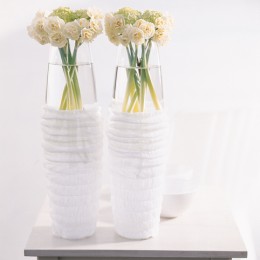
info about the flowers & plants association |
| the latest events in the flower world |
view the latest flower fashion trends |
green & gorgeous – boost your wellbeing with houseplants |
advice on where to buy & recommended retailers |
data & details about the flower industry |
how
to join and what benefits we can offer you as a member |
for
journalists & the media – what we can do for you |
index
of pages on this site to aid your navigation |
|
Narcissus
Name: All daffodils
are Narcissus, which is the genus name. According to the International Cultivar
Registration Authority (for Narcissus and for several other flowers that is the
UK's Royal Horticultural Society) daffodil is accepted as a common name for all
members of the Narcissus genus. However, most people think of daffodils as the
single flower, large trumpet yellow ones, which are the most common kind of daffodils,
and call the smaller headed scented varieties, narcissi. The Oxford Dictionary
defines narcissus (plural narcissi) as "any of a group of flowers including
jonquils and daffodils, especially the kind with heavily-scented single white
flowers". In fact, even the growers of the scented varieties (www.scentednarcissi.co.uk)
call all of their products white or yellow, single or multi-headed, "narcissi".The
flower is named after Narcissus in Greek legend (see Trivia below). "Narcissus"
comes from the Greek for "numbness" referring to the narcotic properties
of the plant. Origin: South Western Europe. Grown extensively in the UK - we export daffodils to Holland. First cultivated by the Romans. Colour: Over 25,000 varieties in shades of yellow, white, orange and peachy pink. Availability: Seasonal availability October to April. The Isles of Scilly start the season off in October with the tiny tazetta types. It finishes in April with large trumpet daffodils from Scotland. Varieties: There is a huge number of cultivars, in a range of colours including combinations of white, yellows, oranges and pinks. There are multi-headed tazetta types and some with a strong fragrance. Yellow tazetta narcissi "Soleil d'Or'"and white "Ziva" have the strongest scent, and also make ideal indoor plants as potted bulbs Care Tips: Daffodils and narcissi have sap which is toxic to other flowers. Display separately, leave in water on their own for at least 12 hours before mixing with other flowers and do not recut the stems. Or use specially formulated cut flower food for mixing daffodils with other flowers. If kept cool they will last about 1 week. Trivia: Facts: Narcissi are mainly cultivated in the Channel Isles, the Isles of Scilly, Great Britain and Holland. The daffodil is the emblem of Wales and is worn on St David's Day. Poultry keepers thought the flower unlucky and would not allow it in the home as they believed it would stop their hens laying eggs or the eggs hatching. Prince Charles is paid one daffodil annually as rent for the unattended lands of Scilly. The local Environmental Trust is reponsible for the payment. The daffodil is used by Marie Curie Cancer Care to raise money on National Daffodil Day. They believe it symbolises new hope and life. Mythology: Narcissus in Greek legend fell in love with his own reflection in a stream. He stayed transfixed by the stream and the gods thought he would die of starvation so they changed him into the flower to stay there forever. Zodiac: They are good flowers for Geminis, who like the daffodil's yellow cheerfulness; and Pisces who appreciate the white narcissi's scented delicacy. Feng Shui:Feng Shui adherents believe the flower brings good luck for the next twelve months if forced to bloom at New Year. Language of Flowers: In Victorian times daffodils signified regard, while narcissi meant self-esteem or even vanity. Medicinal: Daffodils are being grown for Galanthine, a substance in the bulbs being used to fight Alzheimer's. The Isles of Scilly growers behind www.scentednarcissi.co.uk handpick scented narcissi to order and dispatch them direct to your door in midnight blue presentation boxes. Visit www.scentednarcissi.co.uk for more information. Churchtown Farm (www.scillyflowers.co.uk) in the Isles of Scilly spesialises in scented narcissi and pinks. Their prices include postage costs.
| |

|